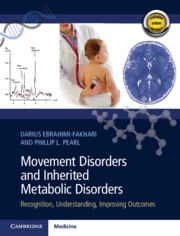Book contents
- Movement Disorders and Inherited Metabolic Disorders
- Movement Disorders and Inherited Metabolic Disorders
- Copyright page
- Dedication
- Contents
- Contributors
- Preface
- Acknowledgments
- Section I General Principles and a Phenomenology-Based Approach to Movement Disorders and Inherited Metabolic Disorders
- Section II A Metabolism-Based Approach to Movement Disorders and Inherited Metabolic Disorders
- Section III Conclusions and Future Directions
- Chapter 30 Metabolic Movement Disorders in the Era of Next-Generation Sequencing
- Chapter 31 Deep Brain Stimulation for Metabolic Movement Disorders
- Chapter 32 Novel Therapeutic Approaches to Metabolic Movement Disorders
- Closing Remarks: A Clinical Approach to Inherited Metabolic Movement Disorders
- Appendix: Video Captions
- Index
- References
Chapter 30 - Metabolic Movement Disorders in the Era of Next-Generation Sequencing
from Section III - Conclusions and Future Directions
Published online by Cambridge University Press: 24 September 2020
- Movement Disorders and Inherited Metabolic Disorders
- Movement Disorders and Inherited Metabolic Disorders
- Copyright page
- Dedication
- Contents
- Contributors
- Preface
- Acknowledgments
- Section I General Principles and a Phenomenology-Based Approach to Movement Disorders and Inherited Metabolic Disorders
- Section II A Metabolism-Based Approach to Movement Disorders and Inherited Metabolic Disorders
- Section III Conclusions and Future Directions
- Chapter 30 Metabolic Movement Disorders in the Era of Next-Generation Sequencing
- Chapter 31 Deep Brain Stimulation for Metabolic Movement Disorders
- Chapter 32 Novel Therapeutic Approaches to Metabolic Movement Disorders
- Closing Remarks: A Clinical Approach to Inherited Metabolic Movement Disorders
- Appendix: Video Captions
- Index
- References
Summary
Suspecting a genetic etiology for movement disorders of childhood often requires a high index of suspicion due to the heterogenous phenotypic expression, variable penetrance, and the influence of epigenetic modifiers that are largely unknown.
- Type
- Chapter
- Information
- Movement Disorders and Inherited Metabolic DisordersRecognition, Understanding, Improving Outcomes, pp. 365 - 374Publisher: Cambridge University PressPrint publication year: 2020



